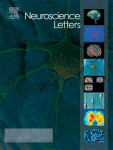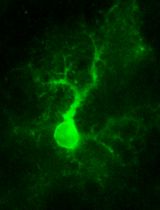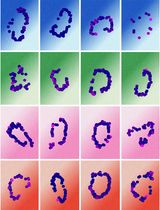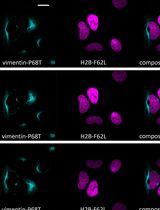- EN - English
- CN - 中文
Analysis of the Mitochondrial Membrane Potential Using the Cationic JC-1 Dye as a Sensitive Fluorescent Probe
用阳离子JC-1染料作为敏感荧光探针进行线粒体膜电势分析
发布: 2019年01月05日第9卷第1期 DOI: 10.21769/BioProtoc.3128 浏览次数: 33749
评审: Fereshteh AzediAnonymous reviewer(s)
Abstract
In recent years, fluorescent dyes have been frequently used for monitoring mitochondrial membrane potential to evaluate mitochondrial viability and function. However, the reproducibility of the results across laboratories strongly depends upon following well validated and reliable protocols along with the appropriate controls. Herein, we provide a practical user guide for monitoring mitochondrial membrane potential in whole cells using a fluorescent cationic probe. The data analysis of mitochondrial membrane potential we provide is one associated with the impact of xenobiotics such as tobacco smoking on blood-brain barrier endothelial cells including both mouse primary (mBMEC) and a mouse-based endothelial cell line (bEnd3) in a side by side comparison.
Keywords: Mitochondrial membrane potential (线粒体膜电势)Background
Apoptosis is a cellular process which involves genetical events causing the death of a cell. Several major events occur in mitochondria, of which, the most significant is the loss of mitochondrial transmembrane potential (ΔΨM) (Green and Reed, 1998). Throughout the life of a cell, the mitochondria uses oxidizable substrates to produce an electrochemical proton gradient across the mitochondrial membrane which is used to produce ATP. The direction of the mitochondrial membrane potential (with the interior of the organelle being electronegative) is such to produce inward transport of cations and outward transport of anions, thus promoting accumulation of cations in the mitochondria (Zorova et al., 2018). This electrochemical gradient drives the synthesis of ATP. However, during apoptosis, ΔΨM decreases as the process is associated with the opening of the mitochondrial permeability pores and loss of the electrochemical gradient. Thus, ΔΨM is an essential parameter of the mitochondrial function that can be used as an indicator of cell health since mitochondria are inherently involved in the apoptotic process of cells.
In recent years, ΔΨM has been studied using several fluorescent cationic dyes including rhodamine-123 and DiOC6 as common monitoring tools (Cossarizza and Salvioli, 1998). The technique involving using 5,5,6,6’-tetrachloro-1,1’,3,3’ tetraethylbenzimi-dazoylcarbocyanine iodide (JC-1) dye has been developed to detect ΔΨM in healthy and apoptotic cells across multiple cell types, such as neurons, myocytes, endothelial cells etc. JC-1 can be used to assess the ΔΨM both in intact isolated mitochondria and tissues. In fact, the JC-1 dye is a lipophilic, cationic dye (naturally exhibiting green fluorescence) which is able to enter into the mitochondria where it accumulates and (in a concentration-dependent manner) starts forming reversible complexes called J aggregates. Differently, from JC-1 molecules, these J aggregates exhibit excitation and emission in the red spectrum (maximum at ~590 nm) instead of green. Thus, in healthy cells with a normal ΔΨM, the JC-1 dye enters and accumulates in the energized and negatively charged mitochondria and spontaneously forms red fluorescent J-aggregates. By contrast, in unhealthy or apoptotic cells the JC-1 dye also enters the mitochondria but to a lesser degree since the inside of the mitochondria is less negative because of increased membrane permeability and consequent loss of electrochemical potential. Under this condition, JC-1 does not reach a sufficient concentration to trigger the formation of J aggregates thus retaining its original green fluorescence.
Based on these premises, the red/green fluorescence ratio of the dye in the mitochondria can be considered as a direct assessment of the state of the mitochondria polarization whereas the higher is the ΔΨM, the more elevated is the red shift of the dye (more J aggregates are formed). Vice-versa; the lower is the ΔΨM of the mitochondria and the lower is the red to green ratio of the fluorescent marker (few J aggregates are formed). Therefore, mitochondrial depolarization is indicated by a reduction in the red to green fluorescence intensity ratio.
The aggregate green monomeric form has absorption/emission of 510/527 nm, and the aggregate red form has absorption/emission 585/590 nm (Smiley et al., 1991). The red to green fluorescence intensity ratio is only dependent on the membrane potential and no other factors such as shape, mitochondrial size, and density, which may influence single-component fluorescence signals. It is noteworthy JC-1 dye can be used both as qualitative (considering the shift from green to red fluorescence emission) and quantitative (considering only the pure fluorescence intensity) measure of mitochondrial membrane potential (Cossarizza and Salvioli, 1998).
Fluorescent dye accumulation in mitochondria can be optically detected by flow cytometry, fluorescent microscopy, confocal microscopy, and through the use of a fluorescence plate reader (Perry et al., 2011). Indeed, the use of fluorescence ratio detection provides researchers with a means to compare measurements of membrane potential while also assessing the percentage of mitochondrial depolarization occurring in a pathological condition (e.g., cellular stress, apoptosis, etc.).
Thus, the main objective of this paper is to provide a practical step by step user protocol to assess and monitor mitochondrial membrane potential in whole cells using the JC-1 fluorescent cationic probe. As a positive control, carbonyl cyanide m-chlorophenyl hydrazone (CCCP) which is a chemical inhibitor of oxidative phosphorylation, affecting the protein synthesis reactions in seedling mitochondria and causing the gradual destruction of living cells and death of the organism is used. In order to illustrate an example for the use of the JC-1 dye, we also provide data analysis related to the mitochondrial membrane potential of two types of mouse-derived brain microvascular endothelial cells subjected to oxidative stress insults by exposure to tobacco.
Materials and Reagents
- Pipette tips (Eppendorf, catalog number: 022491083)
- Sterile centrifuge tube
- Glass coverslips (typically 22 x 22 mm or 22 x 50 mm in Square and Rectangular Sizes respectively)
- Petri dish (typically 100 x 21 mm or 35 x 10 mm based on the experiment design, Thermo Fisher Scientific, USA)
- 96-well plate or chamber slides
- Foil
- BDTM CS&T beads
- JC-1 dye (lyophilized) (MitoProbe JC-1 Assay Kit, Thermo Fisher Scientific, USA, catalog number: M34152)
- Carbonyl cyanide 3-chlorophenylhydrazone (CCCP) (MitoProbe JC-1 Assay Kit, Thermo Fisher Scientific, USA, catalog number: M34152)
- Phosphate-buffered saline (PBS) (Sigma-Aldrich, catalog number: D8537)
- Dimethyl sulfoxide (DMSO) (MitoProbe JC-1 Assay Kit, Thermo Fisher Scientific, USA, catalog number: M34152; or Sigma-Aldrich, catalog number: D5879)
- 50 mM CCCP (solvent: DMSO)
- BD FC Bead 4c Plus Research Kit
- FC Bead 4c Research Kits
- FC Bead Violet Research Kits
Equipment
- Pipettes (Eppendorf)
- Incubator
- Microcentrifuge (e.g., SorvallTM LegendTM Micro 21R Microcentrifuge) or a comparable instrument is suggested) (Thermo Fisher Scientific, model: SorvallTM LegendTM Micro 21R), including 24 x 1.5/2.0 ml Rotor with Click Seal (Biocontainment, catalog number: 75002447)
- Flow cytometer, equipped with a 488 nm argon excitation laser, and bandpass filters designed to detect rhodamine or Texas Red dye (BD FACSCalibur System or comparable platform) (BD, model: FACSCaliburTM)
- Valid alternatives include either a fluorescence microscope (EVOSTM FL color Imaging System, catalog number: AMEFC4300) with a dual-bandpass filter designed to simultaneously detect fluorescein and rhodamine or fluorescein and Texas Red dyes or a fluorescence plate reader (SynergyTM Mx Monochromator-Based Multi-Mode Microplate Reader-BioTek, catalog number: 236219) equipped with laser/fluorescent filters and black 96-well plates
Software
- FACSuite software
Procedure
文章信息
版权信息
© 2019 The Authors; exclusive licensee Bio-protocol LLC.
如何引用
Sivandzade, F., Bhalerao, A. and Cucullo, L. (2019). Analysis of the Mitochondrial Membrane Potential Using the Cationic JC-1 Dye as a Sensitive Fluorescent Probe. Bio-protocol 9(1): e3128. DOI: 10.21769/BioProtoc.3128.
分类
神经科学 > 细胞机理 > 线粒体
神经科学 > 细胞机理 > 胞内信号传导
细胞生物学 > 细胞成像 > 荧光
您对这篇实验方法有问题吗?
在此处发布您的问题,我们将邀请本文作者来回答。同时,我们会将您的问题发布到Bio-protocol Exchange,以便寻求社区成员的帮助。
Share
Bluesky
X
Copy link












